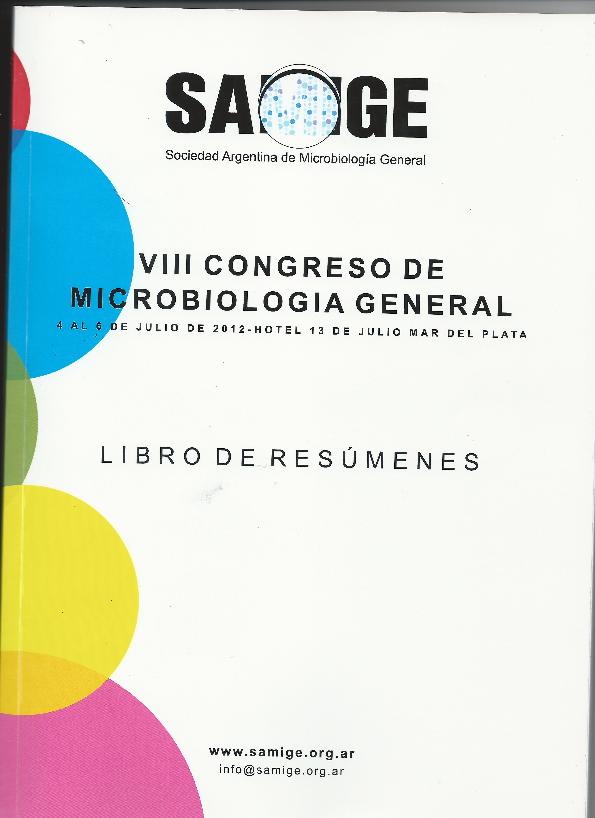Mostrar el registro sencillo del ítem
dc.contributor.author
Bourguignon, Natalia

dc.contributor.author
Isaac, Paula

dc.contributor.author
Amoroso, Maria Julia del R.

dc.contributor.author
Ferrero, Marcela Alejandra

dc.date.available
2023-03-20T13:58:27Z
dc.date.issued
2012
dc.identifier.citation
Biodegradation of polycyclic aromatic hydrocarbons (PAH) by actinomycetes strains; VIII Congreso Argentino de Microbiología; Mar del Plata; Argentina; 2012; 1-2
dc.identifier.uri
http://hdl.handle.net/11336/190990
dc.description.abstract
Among the most abundant environmental pollutants, polycyclic aromatic hydrocarbons (PAH) are one of the major concerns because of their persistence and toxicity. PAH are ubiquitous in nature widespread along the environment in air, water, sediments and soil as a result of both natural and anthropogenic activities. A high diversity of bacterial strains with the ability to degrade multiple PAH can be detected by combining selective enrichment and molecular analyses, in order to follow the enrichment process and to characterize those isolates grown in pure cultures. Due to their importance and metabolic versatility, actinomycetes strains were studied for their capability of degradation of naphthalene, phenantrene or pyrene. Rhodococcus sp. 20, R.jostii, Streptomyces sp. A2, Streptomyces sp. A12 isolated from contaminated soils were selectively growth on agar medium added with crystals of naphthalene, phenantrene or pyrene. Removal of PAH was performed in minimal medium (MM) supplemented with 0.2 mM of each hydrocarbon (stock solutions 25 mM in acetone) and 0.1% yeast extract. The medium was inoculated with spore suspension or 5% v/v. The flasks were incubated at 30 ± 1°C, 150 rpm, for 7 days. Residual PAH was extracted with acetone and furhter determined by HPLC. Bacterial growth was determined by dry weight. Degradation of naphthalene was observed in all isolates at different rates, between 31.2 and 74.8 % of PAH added to the culture medium. R.jostii had the best performance with 74.8 % of degradation. However, R.jostii was unable to degrade phenantrene and pyrene. Degradation of phenantrene only occurred in cultures of Streptomyces sp. A2 (3.9 %) and Streptomyces sp. A12 (20 %), while pyrene only was degradaded by Streptomyces sp. A12 (4.3 %). Because of the poor performance of the strains when growing on phenantrene and pyrene, Streptomyces sp. A2, Streptomyces sp. A12, Rhodococcus sp. 20 and R. jostii were challenged to an adaptation assay that consisted in streaks successive on plate with PAH (0.05 mM) and decreasing concentration of glucose (from 10 to 1.25 gL-1). Then, adapted strains were precultured in a rich media for further inoculation (2g L-1 or 5%v/v) on MM+PAH (phenantrene or pyrene 0.1 mM) and glucose (1.25 gL-1) as a co-substrate. Culture conditions and residual phenantrene or pyrene quantification were followed as previously described. An enhanced degradation of phenantrene and pyrene was observed in the presence of glucose as co-substrate of growth, even that strains who could not degrade these PAH: Rhodococcus strains in both phenantrene and pyrene reached degradation rates of 25% of phenantrene and 19% of pyrene. These results allow us to have hope for the usefulness of these actimycetes strains in bioremediation assays of PAH in the environment.
dc.format
application/pdf
dc.language.iso
eng
dc.publisher
Sociedad Argentina de Microbiología General
dc.rights
info:eu-repo/semantics/openAccess
dc.rights.uri
https://creativecommons.org/licenses/by-nc-sa/2.5/ar/
dc.subject
BIODEGRADATION
dc.subject
PAH
dc.subject
ACTINOMYCETES
dc.subject.classification
Otras Biotecnología del Medio Ambiente

dc.subject.classification
Biotecnología del Medio Ambiente

dc.subject.classification
INGENIERÍAS Y TECNOLOGÍAS

dc.title
Biodegradation of polycyclic aromatic hydrocarbons (PAH) by actinomycetes strains
dc.type
info:eu-repo/semantics/publishedVersion
dc.type
info:eu-repo/semantics/conferenceObject
dc.type
info:ar-repo/semantics/documento de conferencia
dc.date.updated
2023-03-15T20:38:49Z
dc.journal.pagination
1-2
dc.journal.pais
Argentina

dc.journal.ciudad
Mar del Plata
dc.description.fil
Fil: Bourguignon, Natalia. Consejo Nacional de Investigaciones Científicas y Técnicas. Centro Científico Tecnológico Conicet - Tucumán. Planta Piloto de Procesos Industriales Microbiológicos; Argentina
dc.description.fil
Fil: Isaac, Paula. Consejo Nacional de Investigaciones Científicas y Técnicas. Centro Científico Tecnológico Conicet - Tucumán. Planta Piloto de Procesos Industriales Microbiológicos; Argentina
dc.description.fil
Fil: Amoroso, Maria Julia del R.. Consejo Nacional de Investigaciones Científicas y Técnicas. Centro Científico Tecnológico Conicet - Tucumán. Planta Piloto de Procesos Industriales Microbiológicos; Argentina
dc.description.fil
Fil: Ferrero, Marcela Alejandra. Consejo Nacional de Investigaciones Científicas y Técnicas. Centro Científico Tecnológico Conicet - Tucumán. Planta Piloto de Procesos Industriales Microbiológicos; Argentina
dc.relation.alternativeid
info:eu-repo/semantics/altIdentifier/url/https://samige.org.ar/wp-content/uploads/2022/10/Libro-SAMIGE-2012.pdf
dc.conicet.rol
Autor

dc.conicet.rol
Autor

dc.conicet.rol
Autor

dc.conicet.rol
Autor

dc.coverage
Nacional
dc.type.subtype
Congreso
dc.description.nombreEvento
VIII Congreso Argentino de Microbiología
dc.date.evento
2012-07-04
dc.description.ciudadEvento
Mar del Plata
dc.description.paisEvento
Argentina

dc.type.publicacion
Book
dc.description.institucionOrganizadora
Asociación Argentina de Microbiología
dc.source.libro
VIII Congreso Argentino de Microbiología
dc.date.eventoHasta
2012-07-06
dc.type
Congreso
Archivos asociados
